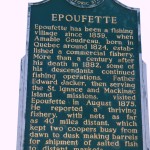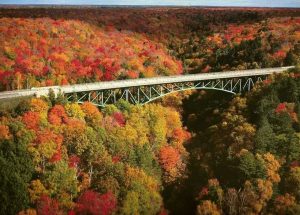Epoufette is a residential community that exists mostly down on the Epoufette Bay Rd. (Lake Michigan) where a point on the west end is where most of the commercial fishing took place and a newer boat launch in this historic little village approximately 25 miles west of the Mackinac Bridge on U.S. #2. Most noted for the Cut River Bridge, its history dates back hundreds of years but mostly for the French fishermen who discovered this beautiful little area, once rich in fishing and lumbering, (in the mid 1880’s).
A short stretch of commercial activity includes the Cut River Inn, Bay View Restaurant, a motel, little trading post and new boat launch, (only one between St. Ignace and Naubinway. Just west is the popular Hog Island Country Store.
A commercial Sand Development business is located between Brevort and Epoufette and the sand is tunnelled under U.S. #2 and loaded onto large freighters where it is delivered to large ports on the Great Lakes for the making of glass and sand blasting mechanical parts for the auto industry and others.
Pronounced “E-po-fett”.
A couple of State parks are located in this stretch and include Hog Island State Beach (also part of the Great Waters Trail System) and the Cut River Bridge park area where you can make the almost 150 ft. climb down and discover a most beautiful mix of rock and sand and a beautiful little river emptying out into Lake Michigan. There is a beautiful overlook that is located just west of town on the U.S. #2 Scenic Byway.

From Wikepedia
- Epoufette is an unincorporated community in the township on US 2 on Lake Michigan at
 46°03′20″N 85°10′06″W.[7] In 1848, a government surveyor, John R. McLeod, found an Indian village here. Amable Goudreau began a commercial fishing business here in 1859, but it did not get a post office until lumbering operations began. McLeod became the first postmaster in December 1879. The name, French for “place of rest”, was given by early French settlers because it was believed that Father Jacques Marquette used the harbor as the first step on his trip down Lake Michigan from St. Ignace.[5] A historical marker commemorating the fishing village was erected in 1986.[8] A summer post office operated here from 1959–1965 and 1966-1972.[9]
46°03′20″N 85°10′06″W.[7] In 1848, a government surveyor, John R. McLeod, found an Indian village here. Amable Goudreau began a commercial fishing business here in 1859, but it did not get a post office until lumbering operations began. McLeod became the first postmaster in December 1879. The name, French for “place of rest”, was given by early French settlers because it was believed that Father Jacques Marquette used the harbor as the first step on his trip down Lake Michigan from St. Ignace.[5] A historical marker commemorating the fishing village was erected in 1986.[8] A summer post office operated here from 1959–1965 and 1966-1972.[9] - Most of the township is served by the 49762 ZIP code for Naubinway in adjacent Hudson Township.[10] The northwest portion of the township is served by the 49793 ZIP code for Trout Lake in Chippewa County.
Caffey, along with the nearby Caffey Corner, was a lumber settlement at  46°10′08″N 85°11′07″W. It is on H-40. West of Caffey, H-40 is also known as the Hiawatha Trail. At Caffey Corner, the Hiawatha Trail branches off to the south to end at US 2 east of Epoufette. H-40 continues east from Caffey approximately seven miles to Trout Lake and from there on to Rudyard just west of I-75.[3][4] Its station on theMinneapolis, St. Paul and Sault Ste. Marie Railway was originally called “Lewis”, but because at the time there was another post office named Lewis in Michigan, it was given a post office named “Caffey”, after the Pennsylvania-born Civil War veteran, William N. Caffey, who became the first postmaster in November 1899. The office cloase in September 1909 and re-opened with Caffey as postmaster in June 1913. The post office closed permanently in December 1916.[5][6]
46°10′08″N 85°11′07″W. It is on H-40. West of Caffey, H-40 is also known as the Hiawatha Trail. At Caffey Corner, the Hiawatha Trail branches off to the south to end at US 2 east of Epoufette. H-40 continues east from Caffey approximately seven miles to Trout Lake and from there on to Rudyard just west of I-75.[3][4] Its station on theMinneapolis, St. Paul and Sault Ste. Marie Railway was originally called “Lewis”, but because at the time there was another post office named Lewis in Michigan, it was given a post office named “Caffey”, after the Pennsylvania-born Civil War veteran, William N. Caffey, who became the first postmaster in November 1899. The office cloase in September 1909 and re-opened with Caffey as postmaster in June 1913. The post office closed permanently in December 1916.[5][6]
Geography
According to the United States Census Bureau, the township has a total area of 81.1 square miles (210 km2), of which, 78.9 square miles (204 km2) of it is land and 2.2 square miles (5.7 km2) of it (2.72%) is water.
Demographics
As of the census[1] of 2000, there were 183 people, 78 households, and 51 families residing in the township. The population density was 2.3 per square mile (0.9/km²). There were 173 housing units at an average density of 2.2 per square mile (0.8/km²). The racial makeup of the township was 83.61% White, 10.93% Native American, 0.55% Asian, and 4.92% from two or more races. Hispanic or Latino of any race were 1.64% of the population.
There were 78 households out of which 25.6% had children under the age of 18 living with them, 56.4% were married couples living together, 6.4% had a female householder with no husband present, and 34.6% were non-families. 29.5% of all households were made up of individuals and 6.4% had someone living alone who was 65 years of age or older. The average household size was 2.35 and the average family size was 2.82.
In the township the population was spread out with 25.7% under the age of 18, 1.6% from 18 to 24, 29.0% from 25 to 44, 25.7% from 45 to 64, and 18.0% who were 65 years of age or older. The median age was 40 years. For every 100 females there were 110.3 males. For every 100 females age 18 and over, there were 103.0 males.
The median income for a household in the township was $32,500, and the median income for a family was $33,906. Males had a median income of $27,083 versus $11,875 for females. The per capita income for the township was $13,772. About 15.3% of families and 23.5% of the population were below the poverty line, including 35.0% of those under the age of eighteen and 18.6% of those sixty five or over.











